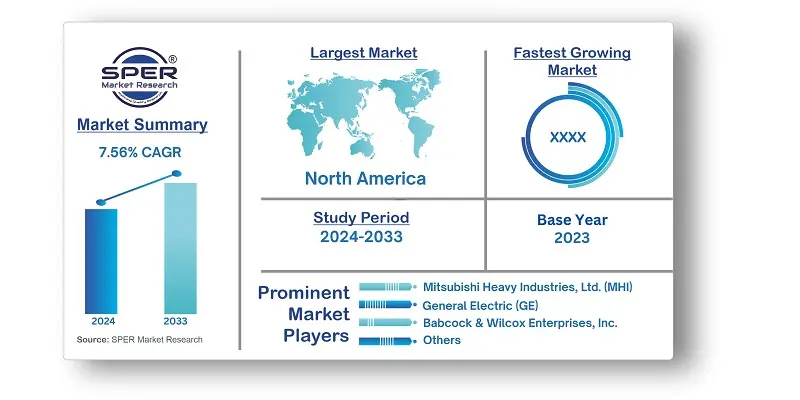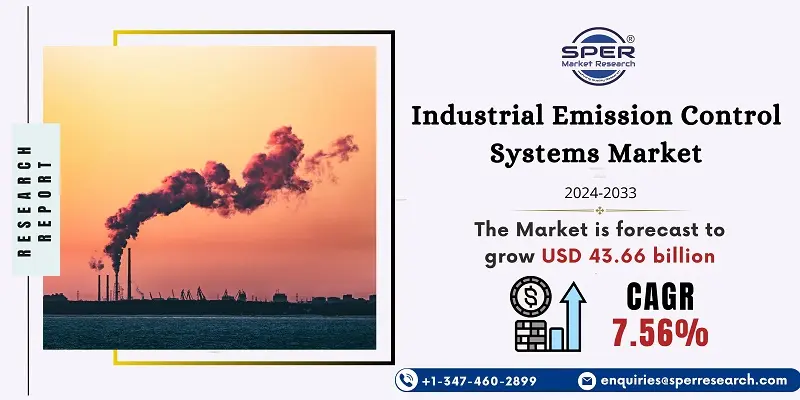
Industrial Emission Control Systems Market Trends, Share, Size, Revenue and Future Outlook
Industrial Emission Control Systems Market Growth, Size, Trend Analysis- By System, By Industry- Regional Outlook, Competitive Strategies and Segment Forecast to 2033
| Published: Nov-2024 | Report ID: POAE2498 | Pages: 1 - 258 | Formats*: |
| Category : Power & Energy | |||
- April 2023: To cut carbon monoxide (CO) emissions by up to 50%, General Electric began integrating its selective catalytic reduction (SCR) and catalytic oxidation reduction (COR) systems into their LM2500XPRESS aero derivative gas turbines. A sustainable power choice in the aviation derivative business will be provided by the aforementioned installation of emission control systems as a CO emission control technology on their LM2500XPRESS machines, which will lead to market expansion.
- January 2023: In Bankura, West Bengal, India, Thermax Limited was awarded a USD 30.8 million order to upgrade and modernise electrostatic precipitators at a 3x210 MW thermal power station. Design, engineering, manufacture, civil work, dismantling/relocation, installation, and commissioning of the ESP systems are all included in the scope of the project in order to reduce particle emissions and meet the air quality standards set for the power plants.


| Report Metric | Details |
| Market size available for years | 2020-2033 |
| Base year considered | 2023 |
| Forecast period | 2024-2033 |
| Segments covered | By System, By Industry. |
| Regions covered | North America, Asia-Pacific, Latin America, Middle East & Africa and Europe. |
| Companies Covered | S.A. HAMON, MITSUBISHI HEAVY INDUSTRIES, LTD., CECO ENVIRONMENTAL, General Electric, Babcock & Wilcox Enterprises, Inc., Thermax Limited, DURR Group, John Wood Group PLC, Fujian Longking Co., Ltd., Others. |
- Manufacturing Companies
- Cement Production Facilities
- Petrochemical and Chemical Processing Plants
- Power Generation Plants
- Mining and Metals Processing Industries
- Oil and Gas Refineries
- Environmental Regulatory Agencies
- Waste Management Facilities
- Renewable Energy Sector
- Engineering, Procurement, and Construction (EPC) Companies
| By System: | |
| By Industry: |
- Global Industrial Emission Control Systems Market Size (FY’2024-FY’2033)
- Overview of Global Industrial Emission Control Systems Market
- Segmentation of Global Industrial Emission Control Systems Market by System (Electrostatic Precipitators, Catalytic Systems, Absorbers, Scrubbers, Others)
- Segmentation of Global Industrial Emission Control Systems Market by Industry (Power Plants, Chemical & Petrochemical Industry, Cement Industry, Metal Industry, Manufacturing industry, Other Sources)
- Statistical Snap of Global Industrial Emission Control Systems Market
- Expansion Analysis of Global Industrial Emission Control Systems Market
- Problems and Obstacles in Global Industrial Emission Control Systems Market
- Competitive Landscape Global Industrial Emission Control Systems Market
- Impact of COVID-19 and Demonetization Global Industrial Emission Control Systems Market
- Details on Current Investment in Global Industrial Emission Control Systems Market
- Competitive Analysis of Global Industrial Emission Control Systems Market
- Prominent Players in the Global Industrial Emission Control Systems Market
- SWOT Analysis of Global Industrial Emission Control Systems Market
- Global Industrial Emission Control Systems Market Future Outlook and Projections (FY’2024-FY’2033)
- Recommendations from Analyst
1.1. Scope of the report1.2. Market segment analysis
2.1. Research data source
2.1.1. Secondary Data2.1.2. Primary Data2.1.3. SPERs internal database2.1.4. Premium insight from KOLs
2.2. Market size estimation
2.2.1. Top-down and Bottom-up approach
2.3. Data triangulation
4.1. Driver, Restraint, Opportunity and Challenges analysis
4.1.1. Drivers4.1.2. Restraints4.1.3. Opportunities4.1.4. Challenges
4.2. COVID-19 Impacts of the Global Industrial Emission Control Systems Market.
5.1. SWOT Analysis
5.1.1. Strengths5.1.2. Weaknesses5.1.3. Opportunities5.1.4. Threats
5.2. PESTEL Analysis
5.2.1. Political Landscape5.2.2. Economic Landscape5.2.3. Social Landscape5.2.4. Technological Landscape5.2.5. Environmental Landscape5.2.6. Legal Landscape
5.3. PORTER’s Five Forces
5.3.1. Bargaining power of suppliers5.3.2. Bargaining power of buyers5.3.3. Threat of Substitute5.3.4. Threat of new entrant5.3.5. Competitive rivalry
5.4. Heat Map Analysis
6.1. Global Industrial Emission Control Systems Market Manufacturing Base Distribution, Sales Area, Product Type6.2. Mergers & Acquisitions, Partnerships, Product Launch, and Collaboration in Global Industrial Emission Control Systems Market
7.1. Global Industrial Emission Control Systems Market Size, Share and Forecast, By System, 2020-20267.2. Global Industrial Emission Control Systems Market Size, Share and Forecast, By System, 2027-20337.3. Electrostatic Precipitators7.4. Catalytic Systems7.5. Absorbers7.6. Scrubbers7.7. Others
8.1. Global Industrial Emission Control Systems Market Size, Share and Forecast, By Industry, 2020-20268.2. Global Industrial Emission Control Systems Market Size, Share and Forecast, By Industry, 2027-20338.3. Power Plants8.4. Chemical & Petrochemical Industry8.5. Cement Industry8.6. Metal Industry8.7. Manufacturing industry8.8. Other Sources
9.1. Global Industrial Emission Control Systems Market Size and Market Share
10.1. Global Industrial Emission Control Systems Market Size and Market Share By Region (2020-2026)10.2. Global Industrial Emission Control Systems Market Size and Market Share By Region (2027-2033)10.3. Asia-Pacific
10.3.1. Australia10.3.2. China10.3.3. India10.3.4. Japan10.3.5. South Korea10.3.6. Rest of Asia-Pacific
10.4. Europe
10.4.1. France10.4.2. Germany10.4.3. Italy10.4.4. Spain10.4.5. United Kingdom10.4.6. Rest of Europe
10.5. Middle East and Africa
10.5.1. Kingdom of Saudi Arabia10.5.2. United Arab Emirates10.5.3. Qatar10.5.4. South Africa10.5.5. Egypt10.5.6. Morocco10.5.7. Nigeria10.5.8. Rest of Middle-East and Africa
10.6. North America
10.6.1. Canada10.6.2. Mexico10.6.3. United States
10.7. Latin America
10.7.1. Argentina10.7.2. Brazil10.7.3. Rest of Latin America
11.1. S.A. HAMON
11.1.1. Company details11.1.2. Financial outlook11.1.3. Product summary11.1.4. Recent developments
11.2. MITSUBISHI HEAVY INDUSTRIES, LTD.
11.2.1. Company details11.2.2. Financial outlook11.2.3. Product summary11.2.4. Recent developments
11.3. CECO ENVIRONMENTAL
11.3.1. Company details11.3.2. Financial outlook11.3.3. Product summary11.3.4. Recent developments
11.4. General Electric
11.4.1. Company details11.4.2. Financial outlook11.4.3. Product summary11.4.4. Recent developments
11.5. Babcock & Wilcox Enterprises, Inc.
11.5.1. Company details11.5.2. Financial outlook11.5.3. Product summary11.5.4. Recent developments
11.6. Thermax Limited
11.6.1. Company details11.6.2. Financial outlook11.6.3. Product summary11.6.4. Recent developments
11.7. DURR Group
11.7.1. Company details11.7.2. Financial outlook11.7.3. Product summary11.7.4. Recent developments
11.8. John Wood Group PLC
11.8.1. Company details11.8.2. Financial outlook11.8.3. Product summary11.8.4. Recent developments
11.9. Fujian Longking Co., Ltd.
11.9.1. Company details11.9.2. Financial outlook11.9.3. Product summary11.9.4. Recent developments
11.10. Others
SPER Market Research’s methodology uses great emphasis on primary research to ensure that the market intelligence insights are up to date, reliable and accurate. Primary interviews are done with players involved in each phase of a supply chain to analyze the market forecasting. The secondary research method is used to help you fully understand how the future markets and the spending patterns look likes.
The report is based on in-depth qualitative and quantitative analysis of the Product Market. The quantitative analysis involves the application of various projection and sampling techniques. The qualitative analysis involves primary interviews, surveys, and vendor briefings. The data gathered as a result of these processes are validated through experts opinion. Our research methodology entails an ideal mixture of primary and secondary initiatives.



Frequently Asked Questions About This Report
PLACE AN ORDER
Year End Discount
Sample Report
Pre-Purchase Inquiry
NEED CUSTOMIZATION?
Request CustomizationCALL OR EMAIL US
100% Secure Payment






Related Reports
Our Global Clients
Our data-driven insights have influenced the strategy of 200+ reputed companies across the globe.




















